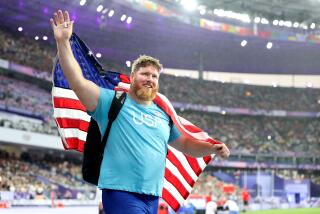Taking Aim at Record : Corona’s Dan Carlisle Shoots Down 3,172 Clay Pigeons in One Hour
- Share via
There are plenty of goofy ways to get into the Guinness Book of World Records.
You can dive from 28 feet into 12 inches of water, hop 120,715 times on a pogo stick without stopping, kiss a friend for 5 1/2 days or grow the largest peanut, 3 1/2 inches.
Dan Carlisle decided he’d stick to what he knows best: blasting clay targets out of the sky with a shotgun.
Carlisle, 34, of Corona, has shot with the last two U.S. Olympic teams, winning a bronze medal in 1984. In Venezuela in ‘82, he shot the only perfect 200/200 score in international trap, and in the ’87 Pan American Games at Indianapolis, he set a record for automatic international trap of 222/225.
Fine credentials, but somehow it’s the offbeat guys who high-dive into sponges and grow giant vegetables that get the notoriety.
No more. Certification is on its way to Guinness headquarters in England that Carlisle has broken the record for clay targets broken in one hour. Last Sunday at Raahauge’s eighth annual Shooting Sports Fair in Norco, he fired 4,590 rounds and knocked down 3,172 (69.1%)--or, one shot every 0.78 seconds and a hit every 1.13 seconds.
“It was tougher than I thought it would be,” Carlisle said. “I thought my arms were going to get tired. They didn’t. It was my legs. My legs were quivering the last 20 minutes.”
By then, he had topped the Guinness-listed record of 2,312 shot by England’s Colin Hewish at the Street and District Gun Club in Ivythorn, Somerset on May 8, 1988.
Dan Reeves of Torrance, an exhibition shooter who is chief instructor for the U.S. Sporting Clays Assn., tried for the record last year at Pachmayr’s International Shooting Sports Park in El Monte but fell 29 short of equaling it, with 2,283. Carlisle watched that effort and learned.
“I said, ‘I think I might be able to do that,’ ” Carlisle said.
But he knew he would have to improve on Reeves’ approach, starting with more people and more firepower. Reeves used 15 guns; Carlisle would have 21. Reeves had a support team of 24 people to reload and otherwise assist; Carlisle would have 55, led by his older brother Ben, his partner in their shooting business, Sport Tec.
Before stepping to the line, Carlisle thought one problem Reeves had was “the kind of guns he used. They were only four-shot guns, while I’m using a seven-shot gun . . . and the arrangement of targets. I’m using all incomers, while he was using a skeet field, shooting by pairs going out from him. And I’ve got a lot more people here to make sure the loading process works right.”
The team included “dippers,” who would dunk the barrel of a discarded gun into a tub of water to cool it, then hand it to the “wipers,” who would pass it along to the loaders.
Beretta loaned its model 1200 automatic riot guns, which allowed Carlisle to fire one shot per squeeze as he emptied the magazine in less than three seconds. Suzuki provided more than 5,000 clay targets at about four cents each, and Remington donated its Premier light reflex shells, 2 1/4 grams with a 7 1/2-8 shot combination, which retail at about 24 cents apiece.
The only rules were that the targets had to be thrown by machine and the guns had to be hand-held.
Ben Carlisle invented everything else.
“There is no established way to do it,” he said minutes before his brother’s attempt. “I think Dan (Reeves) thought he had everything pretty well covered. We started out thinking we could do it with 30 people. We’re now at 55.
“What could happen that I have not accounted for? I have people that know the guns, backup ammunition, backup personnel, water if somebody passes out, extra Band-Aids, hats, socks, gloves, stickum, resin, extra tape--anything that I could think of.”
Four machines would lob the round clay targets toward Dan Carlisle from 50 yards out.
“If we lose one machine, three will easily take care of it,” Ben Carlisle said. “Once they push the button, we’ve got 60 minutes. If Danny gets tired and wants to sit down and rest for five minutes, he loses five minutes. If we lose machines and it’s mechanical, then I get that time back. Anything on this end is my fault.”
Ben Carlisle left nothing to chance. As George Allen did before Super Bowl Super Bowl VII in Los Angeles, he even scouted the sun. “One reason we’re doing it at noon is the sun will be almost straight over us,” he said, “(so) incoming shots shouldn’t be a problem.
“When this thing is over today, there are going to be a lot of people (saying), ‘I can’t believe they did this.’ I can’t help but believe that Colin Hewish had the basic same type of organization. I can’t see it working with any less organization than what we’ve got.”
All Dan Carlisle had to do was shoot.
“Forty-eight minutes,” he said, nervously checking his watch as a crowd of more than a thousand started to fill the bleachers behind the shooting range.
At minus-10 minutes, his mother, Jean, hugged him.
Attendants helped Dan Carlisle tape his hands and put on pads, as if they were preparing a matador for the corrida.
Finally, judges in place, timers ready--Dan Carlisle nodded his head and raised his left hand. Immediately, as many as six targets were in the air at once, floating toward him in a continuous stream against a blue-sky background.
He would shoot from the hip, for two reasons: it would be easier than absorbing 4,590 recoils with his shoulder, and it would be a quicker way to fire while switching guns, especially as his strength ebbed.
In streaks, firing from 10 to 15 yards, he frequently hit 10 or 12 in a row, arousing the crowd into a frenzy over the roar of his guns. Sometimes he missed a few but was able to switch guns with only two seconds between shots. Several times, he stopped to wipe his face and take a drink of water. Otherwise, he kept shooting as attendants doused him with water and placed wet towels on the back of his neck.
At 30 minutes, a scoreboard showed that he was well ahead of the record pace at 1,685, but a crosswind was carrying the targets off to his right--a more difficult shot.
He passed Hewish at 42 minutes 35 seconds, and just kept shooting. By then, the wind was blowing from behind, causing the targets to stall and upsetting his rhythm, or, he thought, he might have had more.
At the end of the hour, Bill Hart of Quail Unlimited called time, and Carlisle’s team lifted him to their shoulders. One judge, Tom Forbes of Beretta, had 3,215 on his hand-held counter. Vic Romano of Remington had 3,196, while Phil Murray of Beretta had 3,107. The average: 3,172.67, which should be good enough for Guinness.
Afterward, Dan Carlisle wore an ice pack on his right hip.
“I’m going to be bruised up a little,” he said. “I had some padding there and stuff wrapped around me to keep the guns from tearing up my insides and bruising up my kidneys, but it was still tough.
“A couple of times I felt like I was getting off track . . . shooting under everything. I’d take a 30-second cool-down break, and it would seem to come right back.
“There was a lot of pressure on me to do it. We had a lot of good organization. It wasn’t just me pulling the trigger. I knew I could do that.”
More to Read
Go beyond the scoreboard
Get the latest on L.A.'s teams in the daily Sports Report newsletter.
You may occasionally receive promotional content from the Los Angeles Times.






